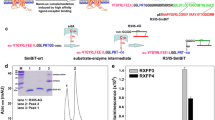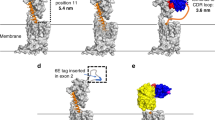Abstract
NanoLuc Binary Technology (NanoBiT) was recently developed by Promega, based on a large NanoLuc fragment (LgBiT) and two small complementation tags, the low-affinity SmBiT tag and the high-affinity HiBiT tag. In recent studies, we applied NanoBiT to ligand–binding assays of some G protein-coupled receptors via genetic fusion of a secretory LgBiT (sLgBiT) to the extracellular N-terminus of the receptors and covalent attachment of the low-affinity SmBiT tag to an appropriate position of their peptide ligands. The NanoBiT-based homogenous ligand–receptor binding assay is convenient for use and suitable for both the wild-type and mutant receptors, representing a novel tool for interaction mechanism studies of these receptors with their ligands. In the present chapter, we provide detailed protocols for setting up the NanoBiT-based homogenous binding assay using growth hormone secretagogue receptor type 1a (GHSR1a) and its endogenous agonist and antagonist as a representative model system.
Access this chapter
Tax calculation will be finalised at checkout
Purchases are for personal use only
Similar content being viewed by others
References
Zambito G, Chawda C, Mezzanotte L (2021) Emerging tools for bioluminescence imaging. Curr Opin Chem Biol 63:86–94
Syed AJ, Anderson JC (2021) Applications of bioluminescence in biotechnology and beyond. Chem Soc Rev 50:5668–5705
Love AC, Prescher JA (2020) Seeing (and using) the light: recent developments in bioluminescence technology. Cell Chem Biol 27:904–920
Yeh HW, Ai HW (2019) Development and applications of bioluminescent and chemiluminescent reporters and biosensors. Annu Rev Anal Chem (Palo Alto, Calif) 12:129–150
Hall MP, Unch J, Binkowski BF, Valley MP, Butler BL, Wood MG, Otto P, Zimmerman K, Vidugiris G, Machleidt T, Robers MB, Benink HA, Eggers CT, Slater MR, Meisenheimer PL, Klaubert DH, Fan F, Encell LP, Wood KV (2012) Engineered luciferase reporter from a deep sea shrimp utilizing a novel imidazopyrazinone substrate. ACS Chem Biol 7:1848–1857
Dixon AS, Schwinn MK, Hall MP, Zimmerman K, Otto P, Lubben TH, Butler BL, Binkowski BF, Machleidt T, Kirkland TA, Wood MG, Eggers CT, Encell LP, Wood KV (2016) NanoLuc complementation reporter optimized for accurate measurement of protein interactions in cells. ACS Chem Biol 11:400–408
Bodle CR, Hayes MP, O'Brien JB, Roman DL (2017) Development of a bimolecular luminescence complementation assay for RGS: G protein interactions in cells. Anal Biochem 522:10–17
Storme J, Cannaert A, Van Craenenbroeck K, Stove CP (2018) Molecular dissection of the human A3 adenosine receptor coupling with β-arrestin2. Biochem Pharmacol 148:298–307
Schwinn MK, Hoang T, Yang X, Zhao X, Ma J, Li P, Wood KV, Mallender WD, Bembenek ME, Yan ZH (2018) Antibody-free detection of cellular neddylation dynamics of Cullin1. Anal Biochem 555:67–72
Inoue A, Raimondi F, Kadji FMN, Singh G, Kishi T, Uwamizu A, Ono Y, Shinjo Y, Ishida S, Arang N, Kawakami K, Gutkind JS, Aoki J, Russell RB (2019) Illuminating G-protein-coupling selectivity of GPCRs. Cell 177:1933–1947
Peach CJ, Kilpatrick LE, Woolard J, Hill SJ (2021) Use of NanoBiT and NanoBRET to monitor fluorescent VEGF-A binding kinetics to VEGFR2/NRP1 heteromeric complexes in living cells. Br J Pharmacol 178:2393–2411
Schwinn MK, Machleidt T, Zimmerman K, Eggers CT, Dixon AS, Hurst R, Hall MP, Encell LP, Binkowski BF, Wood KV (2018) CRISPR-mediated tagging of endogenous proteins with a luminescent peptide. ACS Chem Biol 13:467–474
Soave M, Kellam B, Woolard J, Briddon SJ, Hill SJ (2020) NanoBiT complementation to monitor agonist-induced adenosine A(1) receptor internalization. SLAS Discov 25:186–194
Sasaki M, Anindita PD, Phongphaew W, Carr M, Kobayashi S, Orba Y, Sawa H (2018) Development of a rapid and quantitative method for the analysis of viral entry and release using a NanoLuc luciferase complementation assay. Virus Res 243:69–74
Ranawakage DC, Takada T, Kamachi Y (2019) HiBiT-qIP, HiBiT-based quantitative immunoprecipitation, facilitates the determination of antibody affinity under immunoprecipitation conditions. Sci Rep 9:6895
Boursier ME, Levin S, Zimmerman K, Machleidt T, Hurst R, Butler BL, Eggers CT, Kirkland TA, Wood KV, Friedman Ohana R (2020) The luminescent HiBiT peptide enables selective quantitation of G protein-coupled receptor ligand engagement and internalization in living cells. J Biol Chem 295:5124–5135
Liang XY, Zhu QC, Liang JQ, Liu SY, Liu DX, Fung TS (2020) Development of HiBiT-tagged recombinant infectious bronchitis coronavirus for efficient in vitro and in vivo viral quantification. Front Microbiol 11:2100
Jones IKA, Streblow DN (2021) Antibody-independent quantification of cytomegalovirus virion protein incorporation using HiBiT. Methods Mol Biol 2244:213–232
Hu MJ, Shao XX, Li HZ, Nie WH, Wang JH, Liu YL, Xu ZG, Guo ZY (2018) Development of a novel ligand binding assay for relaxin family peptide receptor 3 and 4 using NanoLuc complementation. Amino Acids 50:1111–1119
Wang JH, Li HZ, Shao XX, Nie WH, Liu YL, Xu ZG, Guo ZY (2019) Identifying the binding mechanism of LEAP2 to receptor GHSR1a. FEBS J 286:1332–1345
Li HZ, Shou LL, Shao XX, Liu YL, Xu ZG, Guo ZY (2020) Identifying key residues and key interactions for the binding of LEAP2 to receptor GHSR1a. Biochem J 477:3199–3217
Wang JH, Nie WH, Shao XX, Li HZ, Hu MJ, Liu YL, Xu ZG, Guo ZY (2019) Exploring electrostatic interactions of relaxin family peptide receptor 3 and 4 with ligands using a NanoBiT-based binding assay. Biochim Biophys Acta Biomembr 1861:776–786
Li HZ, Li N, Shao XX, Liu YL, Xu ZG, Guo ZY (2020) Hydrophobic interactions of relaxin family peptide receptor 3 with ligands identified using a NanoBiT-based binding assay. Biochimie 177:117–126
Li HZ, Shao XX, Shou LL, Li N, Liu YL, Xu ZG, Guo ZY (2021) Unusual orthologs shed new light on the binding mechanism of ghrelin to its receptor GHSR1a. Arch Biochem Biophys 704:108872
Li HZ, Shou LL, Shao XX, Li N, Liu YL, Xu ZG, Guo ZY (2021) LEAP2 has antagonized the ghrelin receptor GHSR1a since its emergence in ancient fish. Amino Acids 53:939–949
Acknowledgments
This work was supported by the National Natural Science Foundation of China (31971193; 31670773).
Author information
Authors and Affiliations
Corresponding author
Editor information
Editors and Affiliations
Rights and permissions
Copyright information
© 2022 The Author(s), under exclusive license to Springer Science+Business Media, LLC, part of Springer Nature
About this protocol
Cite this protocol
Liu, YL., Guo, ZY. (2022). The NanoBiT-Based Homogenous Ligand–Receptor Binding Assay. In: Kim, SB. (eds) Bioluminescence. Methods in Molecular Biology, vol 2525. Humana, New York, NY. https://doi.org/10.1007/978-1-0716-2473-9_10
Download citation
DOI: https://doi.org/10.1007/978-1-0716-2473-9_10
Published:
Publisher Name: Humana, New York, NY
Print ISBN: 978-1-0716-2472-2
Online ISBN: 978-1-0716-2473-9
eBook Packages: Springer Protocols




